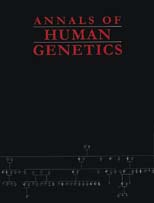No CrossRef data available.
Article contents
A novel method of two-locus linkage analysis applied to a genome scan for late onset Alzheimer's disease
Published online by Cambridge University Press: 09 January 2002
Abstract
A number of methods have previously been described which carry out linkage analysis considering information for two or more loci simultaneously. Apart from some ad hoc methods such as analysing subsamples, these methods use information regarding linkage at all loci under consideration. However, if the actual genotype-specific effects are known for some loci then it would be preferable to consider the genotypes of these loci directly, rather than the amount of allele-sharing they demonstrate. Here we present an extension to our likelihood-based method of model-free linkage analysis as implemented in the MFLINK program. This allows the incorporation of liability classes. The genotypes of a locus known to affect risk can be used to assign subjects to liability classes prior to carrying out linkage tests at other loci. An example application is presented for genome scan data on Alzheimer's disease with analysis conditional on Apoliprotein E (APOE) genotypes. The results provide support for the existence of additional susceptibility loci linked to D10S1211 and to D12S358.
- Type
- Review Article
- Information
- Copyright
- University College London 2001


